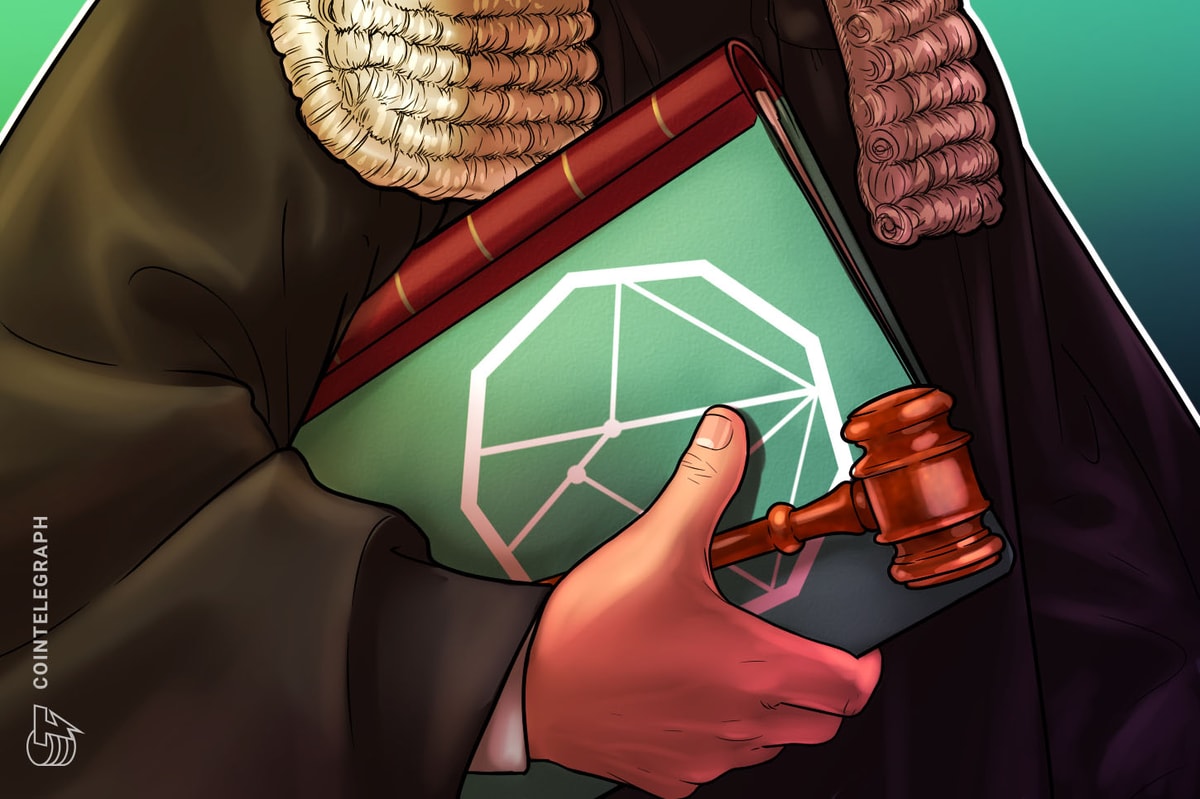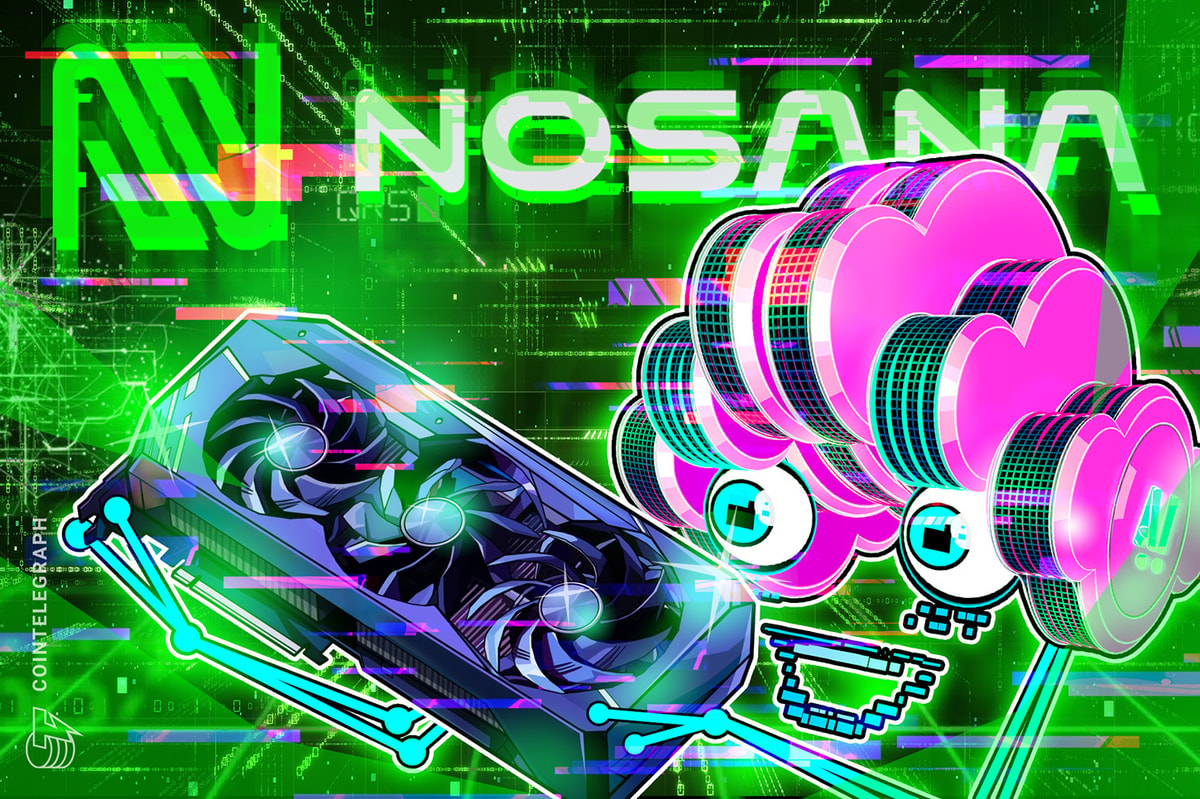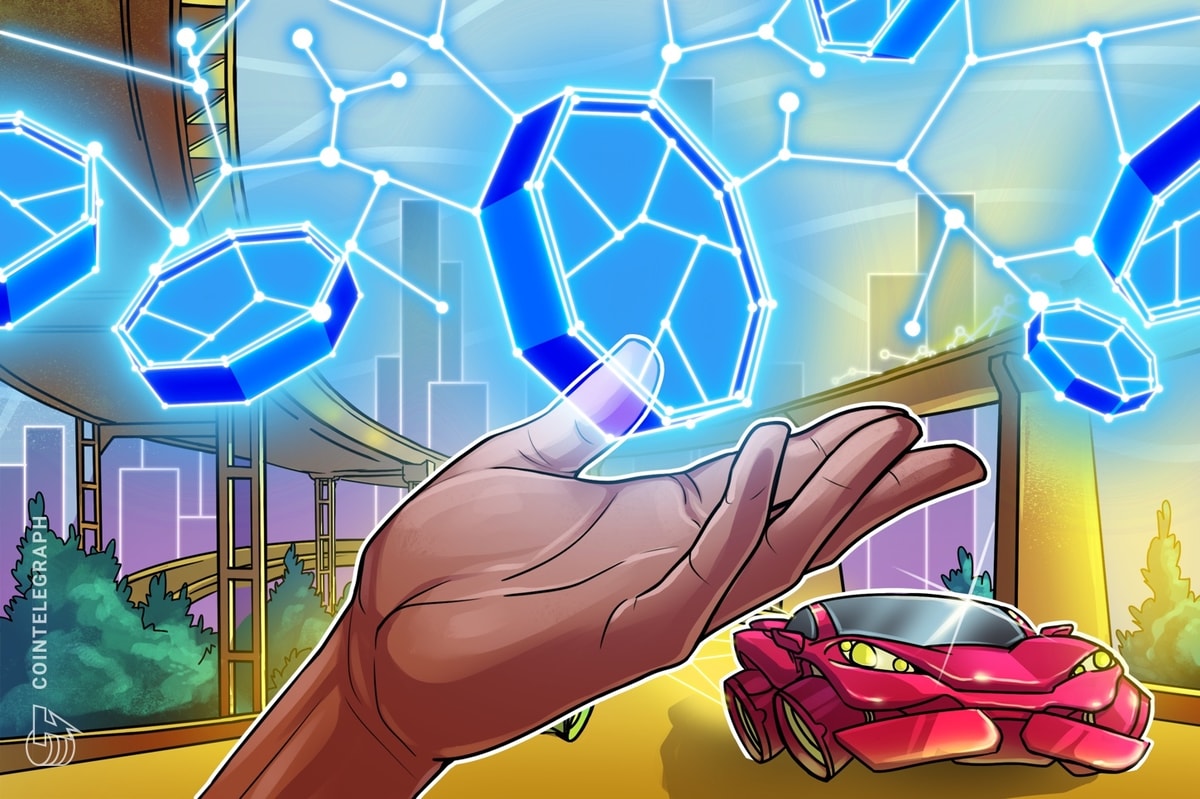
With concepts exploring Bitcoin’s societal impacts and implementation of technologies like augmented reality, the Bitcoin art scene has arrived.
When cryptograffiti quit his day job and dove into creating Bitcoin art full time, the concept of thriving as a Bitcoin professional — let alone one whose beat is visual art — would have been ludicrous to most.
In 2012, this included shredding credit cards for resin sculptures and dabbling in street art, all in the name of the Bitcoin brand.
“It was super risky early on, and having to explain to family what I was doing [was difficult],” he told Bitcoin Magazine. “I started doing street art and I was at this in-between stage with this startup I was working on. And I was like, you know what, this is more interesting. So I decided to go full bore, and if it doesn’t work out, it doesn’t work out.”
So far, it’s more than worked out, as cryptograffiti’s work has become widely recognized throughout the industry. Standouts include his credit card portraits of Hal Finney and Dorian Nakamoto, his “Black Swan” miniature portrait that sold for a fraction of a penny on the Lightning Network and his bolívar charity portrait of Venezuelan President Nicolás Maduro.
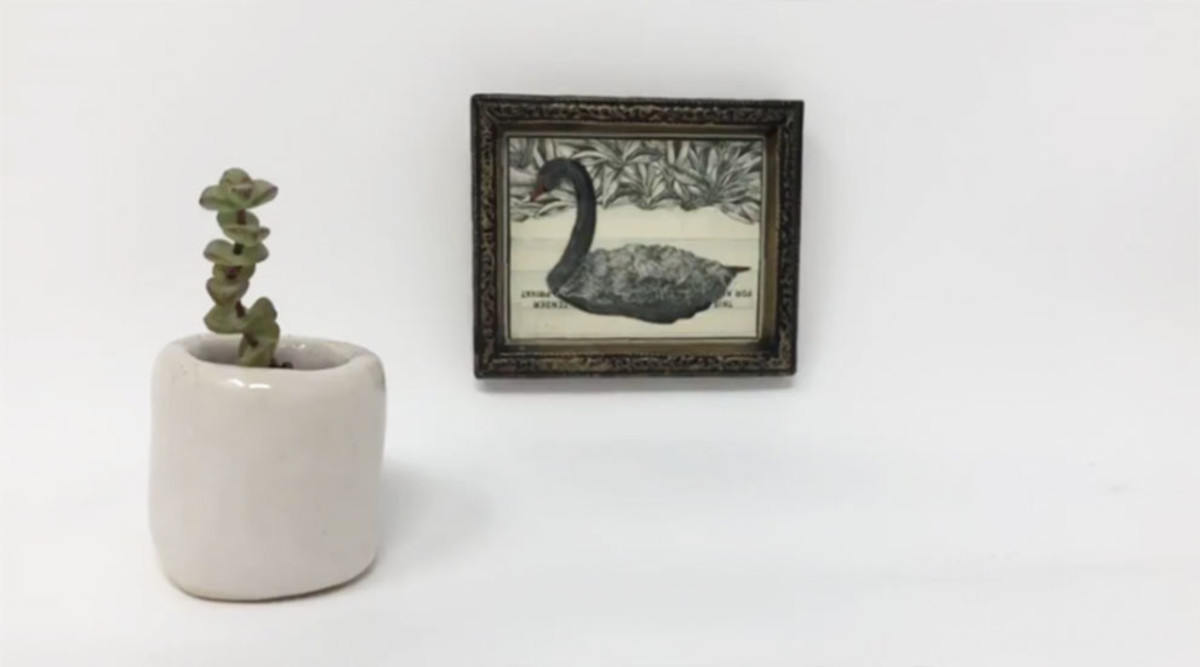
The Black Swan auction sold for 1 millisatoshi (one hundred billionth of one bitcoin).
His art often fuses the political, social and economic themes central to Bitcoin’s core technology, especially with more performative pieces like “Black Swan” and the fiat portrait of Maduro. Viewing something so abstruse and technical through an aesthetic lens makes it relatable, he said; the visual representations, and their potential to relate to the interests and ideologies in Bitcoin’s orbit, bridge the technical gap for people.
“When I first got into this space, I found it hard to grapple with, and I kinda [started] feeling out of place with all this tech culture around me,” cryptograffiti said. “Then I decided to really crack what was going on and I fell down the proverbial rabbit hole and just knew visual imagery would help it spread because it would appeal to more people.”
Sensing art’s potential to spur Bitcoin awareness, he began creating when the Bitcoin art field was practically a nonentity. He could recall a few authors, such as Diego Rodriguez, who had contributed to Bitcoin Magazine’s print editions in 2012 and 2013. Wired’s famed “Rise and Fall of Bitcoin” article played a particularly pointed role in convincing him that art could shape the conversation around Bitcoin.
“I remember thinking, ‘This thing isn’t going away, and there’s going to need to be a way to portray this in the press, making this attractive or just to grab their attention other than just an image of a bitcoin or zeroes and ones with a hacker looking dark,’” he recalled.
The New Bitcoin Art Scene
The opening cryptograffiti saw back then has grown into a subindustry within the wider Bitcoin industry itself. This enclave of crypto creatives, which is “growing in quality and quantity,” as cryptograffiti put it, was on full display at the Bitcoin 2019 conference in San Francisco. Artists dressed Bitcoin up through conventional media like oils and wood, as well as ones that traverse the virtual and physical realms alike.
Josie, for instance, employs augmented reality (AR) to animate her portraits, opening up a new dimension for the viewer to comprehend her artistic vision and the work’s narrative.
“It just continues a story,” she explained. “You see the static image, but once you get into the AR, you can see exactly what’s going on in my head and why I made it — the beginning, the middle and the end.”
One of her more prominent pieces portrays a woman, gas mask strapped on, transposed over a backdrop of USD and gazing intently at the viewer. When viewed through the Artivive AR app, the artwork sheds its USD backing to reveal a new Bitcoin-studded background, and as this transition occurs, her gas mask, with its Bitcoin frontispiece, fades away.
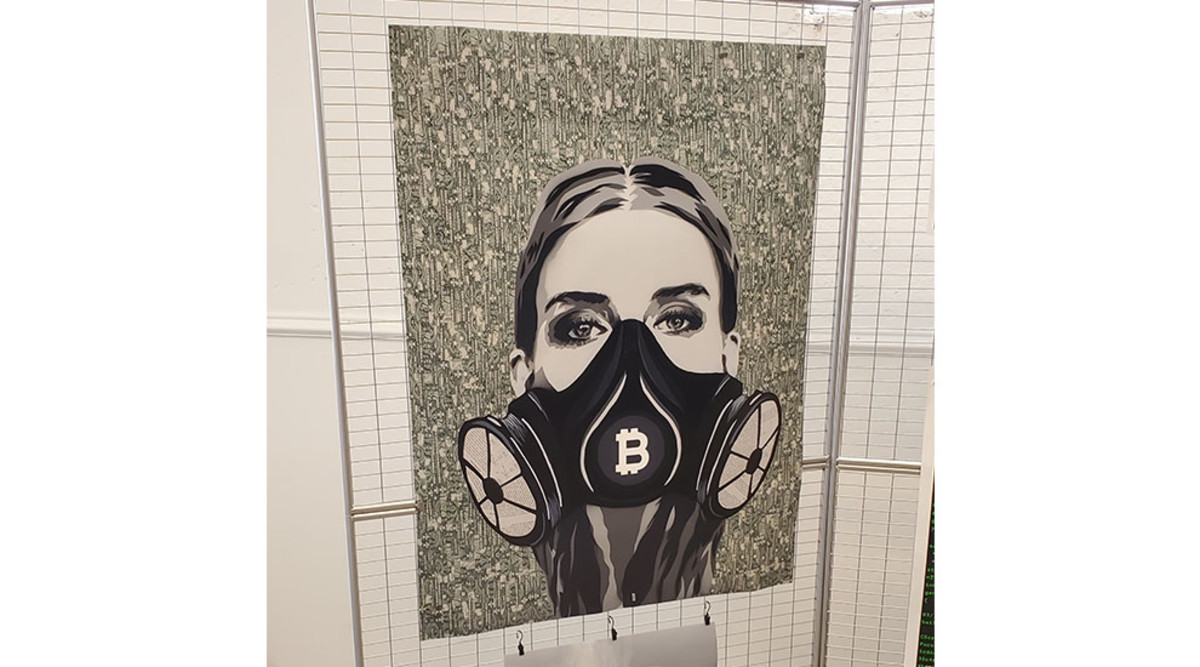
Josie's original gasmask portrait on display at Bitcoin 2019. Experience its AR component on her website by using the Artivive app on your phone.
Josie told Bitcoin Magazine that her work is “always about promoting awareness and adoption” and is a way for her “to tell my story about owning my freedom, my identity, my money.” Her art strives to empower and please. This is why she chooses primarily female subjects, as both a show of empowerment and to suffuse her art with a charm that makes it attractive to people who would otherwise turn away at the sight of Bitcoin.
“I use women in almost all of my pieces because, for me, women are so powerful, so beautiful,” she explained. “They’re bringing life to tech and math and code that no one understands. Women represent life, so I think it’s such a cool way to tie that in. And it gives people something relatable. The story of the art is she’s owning her identity by using bitcoin, and it gives them a sense of empowerment that they can do that as well.”
These representations have kickstarted conversations about what Bitcoin is and give people a chance to learn. That’s what it’s all about, cryptograffiti said, as he recalled his own experiences with capturing people’s curiosity through his art.
Art as a gateway drug for Bitcoin was a common intersection for most of the artists exhibiting at Bitcoin 2019.
“The paintings speak for themselves in a sense, but at the same time, someone who’s not in the crypto space may not know what the bull and the bear represent,” Trevor Jones, whose art also incorporates AR, said. His app supplies viewers with snippets on Bitcoin’s volatility and market cycles. “It’s a more visually dynamic way to engage with the viewer,” a better way to inform them than slapping a description under the pieces themselves.
Speaking to the power of art infused with AR, another artist who exhibited at the conference, Chiefmonkey, said that it helps to “[bridge] a gap” and spark discussion.
“We have an open studio at home, me and my girlfriend, to show people our art, and that’s given me the opportunity to talk to people who don’t know what Bitcoin is,” he said. “Then they see that there’s a whole community of crypto artists, and so it bridges a gap between people who just like art to start learning about bitcoin.
“When I have someone in my home, they’re captive,” he added, with a boom of laughter.
Disrupting More Than Just the Art Scene
Chiefmonkey’s art takes inspiration largely from the Bitcoin community, and the wood-carved Satoshi Series he had on display incorporates Japanese influence to illustrate Bitcoin’s short history. The first piece, “Satoshi Goes Down the Rabbit Hole,” portrays the Bitcoin progenitor’s psychedelic jump into Bitcoin’s multilayered design. Others, like “Ginko Crypto” and “Satoshi Summons the Bulls,” depict bucolic Japanese landscapes with the Bitcoin price disguised as a mountain range in the background.
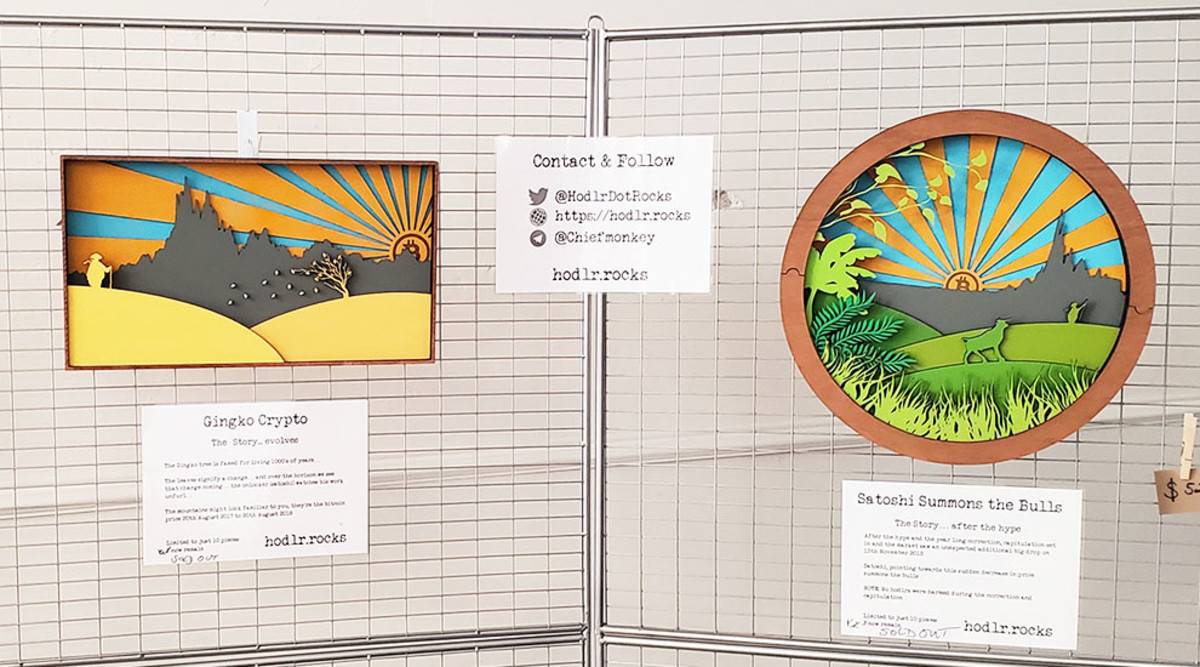
Ginko Crypto and Satoshi Summons the Bull's bucolic Japanese landscapes surreptitiously incorporate bitcoin's most recognized talking point: price.
“My pieces in the future will be more politically challenging,” he said, touching on the need to expand Bitcoin art’s thematic frontier. Many of the artists on display at Bitcoin 2019, he continued, are testaments to how the aesthetic and thematic statements of the genre are maturing.
“On the art side, just sticking a bitcoin logo onto something doesn’t make it art anymore, Chiefmonkey said. “The artists here today are making statements with their art. It is about something, not just of something. Crypto art is as much about politics, a discussion about traditional systems, and I think a lot of us will be doing something about that and opening up the discussion beyond just money.”
To Jones, this includes disrupting and subverting not just the conversion around money and politics but art and culture itself.
“There’s this disruptive quality to the work,” he said. “They didn’t like it in the traditional market, when I was starting to poke the bear with AR. I went into the Scottish National Portrait Gallery and transformed Robert Burns and Hume into industry figures like Pomp, using my AR app.
“It pisses them off and brings a lot of attention,” he concluded.
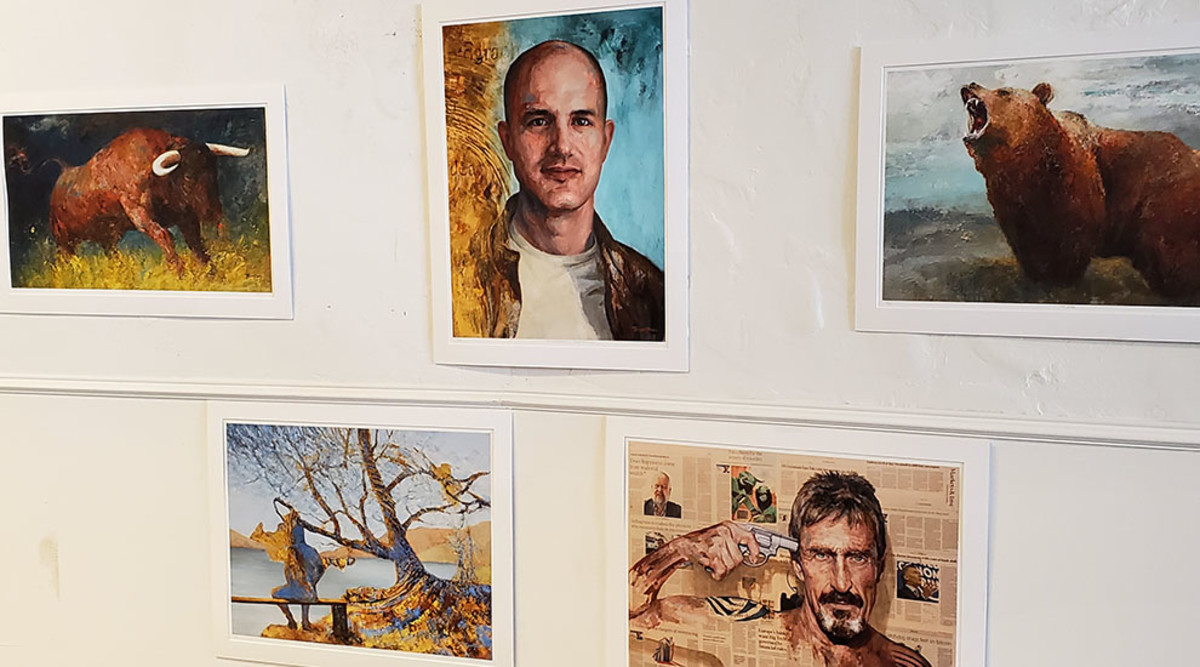
Trevor Jones' portraits of John McAfee and Brian Armstrong of Coinbase among the archetypal Bear and Bull.
The Marriage of Bitcoin and Art: A Long-Term View
Jones, a professional artist of 16 years, found that the traditional art world didn’t take too kindly to his use of AR.
“I was one of the first painters in the world to use AR in 2011 to ’12,” he said. “The art scene is quite conservative, so when I started playing with AR, the traditional galleries weren’t interested in showcasing my work.”
But the Bitcoin sphere, avant-garde in its own right, “has been absolutely phenomenal” with its reception, he said. The intersection of crypto and art is more natural than forced for Bitcoin proponents, and this is part of the reason why the Bitcoin art community is on the rise and so rich in variety.
The only thing that’s missing, according to cryptograffiti, is artists being able to directly monetize their work through Bitcoin and blockchain payment rails.
“It’s still so early that we’re not seeing the benefits of the technology itself for things like micropayments to benefit artists,” he said.
Second-layer solutions like the Lightning Network are one component of this, but another of Bitcoin 2019’s featured artists, Gus Grillasca, thinks non-fungible tokens (NFTs) will complete the picture. This concept for art, funnily enough, dates back to its original application with Pepe Cash — an ecosystem of beloved pepe memes where each “rare pepe” is associated with an NFT built on the Bitcoin secondary protocol, Counterparty.
“Some of us consider the rare pepe wallet as the birth of a digital art movement with these scarce digital tokens,” Grillasca said. We believe that there is a very important movement around creating these scarce tokens. Artists can do all of these things now for revenue sources, to engage with their followers using these tokens.”
Using NFTs, artists can crowdfund through ICOs or distributing digital copies of pieces to their followers.
For Grillasca, who creates NFTs for his work on Counterparty, this means creating, say, 100 NFTs for a certain piece. These tokens are digitally attestable and function like an artist-stamped or -signed copy of the original. This creates a digital scarcity that simulates the scarcity of original works in the real world.
“So what this means is that the digital can become more valuable than the physical,” Grillasca said. “Now, the digital has a market of its own.”
Of course, as with Pepe Cash, anyone can copy the image associated with the token, but without the token itself, this representation will carry no value on the digital art market. Josie also expressed that these NFTs can be used to unlock the AR component of each piece, a feature that Grillasca’s AR-compatible work also includes.
NFTs very well could open a new avenue for artists to monetize their work and make it digitally scarce in ways that the internet’s current structure won’t support. Couple this with something like Lightning Network micropayments and, “It’s only going to be a matter of time before revenue models for creatives will be expanded,” as cryptograffiti said. This would mean Bitcoin’s network effect reaching beyond its subculture of dedicated followers and interacting with a larger section of the world.
“If we want this to really grow and we want all walks of life, we don’t want an uneven power structure to develop [like in the traditional system], and for me that means onboarding people in regions that need it most, being able to get creatives who will appeal to more creatives, and so on,” cryptograffiti concluded.
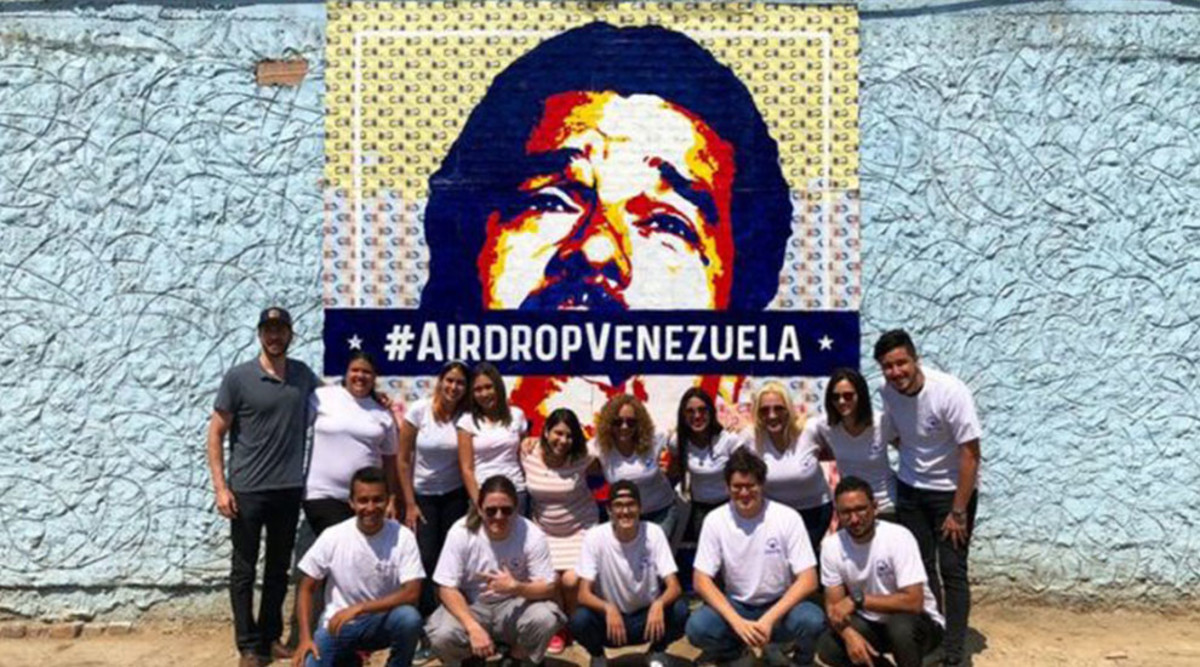
In partnership with Airdrop Venezuela, Cryptograffiti's Maduro mural was constructed entirely of 1,000 bolivars and dismantled live by Venezuelan expats as the charity auction received donations.







